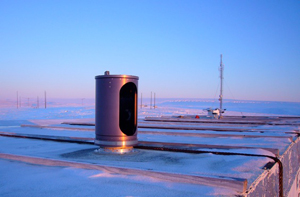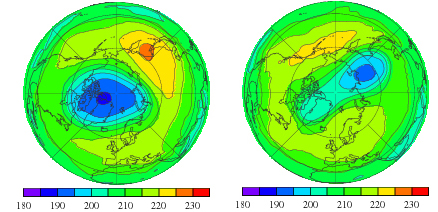Cold vortex puts a northern spin on ozone loss
Mar 23, 2011 - by Staff
Mar 23, 2011 - by Staff
Bob Henson | 23 March 2011 • As nice as it is, the return of sunlight each spring has a few nasty side effects. One of them is sunlight’s ability to catalyze ozone destruction. That process has happened in a big way this month over the Arctic.
As much as 25–38% of the ozone at various altitudes has been destroyed in recent weeks. Extremely cold readings in the stratosphere paved the way for these ozone losses, which are among the biggest ever observed in the Northern Hemisphere. The cold’s been stoked by an unusually strong, deep vortex that has encircled much of the Arctic and persisted much later than usual.

Keeping watch on the Arctic stratosphere from below, this high-resolution infrared Fourier transform spectrometer is funded by NASA and operated by NCAR at a site near Thule, Greenland. (Photo courtesy James Hannigan, NCAR.)
“We’re on the verge of an Arctic ozone hole,” said Markus Rex (Alfred Wegener Institute of Polar and Marine Research) in a nature.com blog post on 15 March. Science News has also covered the unfolding story.
“It’s been extraordinary,” says NCAR atmospheric chemist James Hannigan. Since 1999, he and colleague Michael Coffey have maintained a NASA-funded infrared spectrometer at Thule, on the far northwest coast of Greenland (see photo). One of the two researchers heads to the site each year around the end of February to bring the equipment online before sunlight returns. The solar-viewing spectrometer gathers data on a variety of gases important to air chemistry. Other institutions also keep watch on the Arctic stratosphere through ground- and satellite-based sensors.
Ozone’s two weak spots: south and north
The Arctic has long played runner-up to Antarctica when it comes to ozone depletion. Around the South Pole, the wintertime vortex is typically quite strong, and the lower stratosphere often plummets below –78°C (–108°F). That’s cold enough to foster the growth of polar stratospheric clouds (PSCs). These clouds serve as a platform for ozone destruction as they interact with sunlight and chlorine. Most of the chlorine enters the air via human-produced chloroflourocarbons, the chemicals gradually phased out through the Montreal Protocol since the late 1980s.
In the Northern Hemisphere, irregular topography and other factors help make the Arctic’s polar vortex more prone to disruption and less reliably cold. As a result, the Arctic sees fewer PSCs, and it hasn’t had a recurring ozone hole comparable to Antarctica’s. However, in some years the northern depletion can still be significant, and this is definitely one of those years.
“The Arctic polar vortex has been unusually compact, persistent, and cold,” says Hannigan (see graphic below). “It’s allowed a vast amount of inert hydrochloric acid to be converted into activated chlorine.” Once activated, the chlorine can interact with PSCs to destroy ozone. The data collected by NCAR show that more than 75% of the hydrochloric acid within the vortex has been removed, Hannigan says.

On 10 March 2011 (left), at the center of an unusually strong polar vortex over the Arctic, temperatures dipped below 190 kelvins (the measure of temperature on the scale shown here; 190 K translates to –83°C or –118°F). High-altitude temperatures are measured across a consistent pressure reading, rather than altitude. These temperatures were measured on the pressure surface of 50 hectopascals (50 millibars), which hovers in the lower stratosphere at varying heights near 20 kilometers or 12 miles above sea level. By 22 March (right), the vortex was weakening and elongating, as is more typical for late winter and early spring. (Graphics courtesy NASA/MLS Meteorological Data Plots.)
A ringside seat for ozone destruction
The vortex shifted directly over Thule in early March, giving researchers a rare look at processes within the heart of the coldest air. “That was the luck of the draw. The vortex could be anywhere in the Arctic, but this year it’s overhead,” says Hannigan.
Overall, about one-third of the total ozone normally present through the depth of the atmospheric column above Thule was gone as of 19 March. That’s the largest depletion observed in NCAR’s 12 years of data collection. By comparison, Antarctica typically loses close to two-thirds of its column ozone at the peak of springtime depletion, which occurs there in September.
This week the Arctic vortex is getting stretched between Greenland and Siberia, a harbinger of its long-awaited weakening. “As of two or three days ago, it was still very strong,” says Hannigan. “As it moves round the arctic it tends to distort and break apart eventually, but thus far it’s still held together as a dynamical feature.”
As the vortex degrades, some of its fragments could move over populated high-latitude areas, which would allow more ultraviolet light than usual at this time of year to reach those areas. Even so, the amount of UV would be less than one would normally get during the much stronger sunlight of midsummer.
Warming below, cooling above
This winter’s powerful Arctic vortex is happening within a general cooling of the lower stratosphere over recent decades. While greenhouse gases warm the troposphere near Earth's surface, carbon dioxide also radiates heat back to space at higher altitudes, so it has thus helped produce record low temperatures miles above Earth. Interestingly, in the lower stratosphere, the main driver of cooling is the loss of sunlight-absorbing ozone. [This paragraph updated at 5:40 pm MDT. 3/23/11]
Whatever its implications, it’s clear that the Arctic ozone loss of 2011 has captivated chemists. “This winter’s vortex will be studied for some time,” says Hannigan.